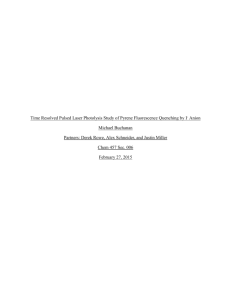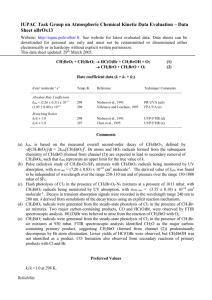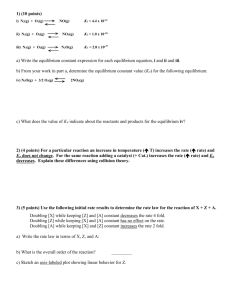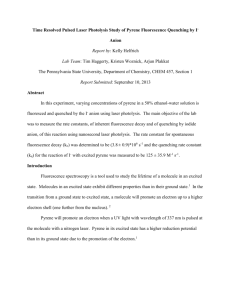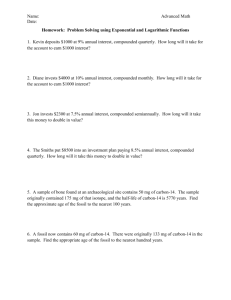File - Morgan Glisan
advertisement
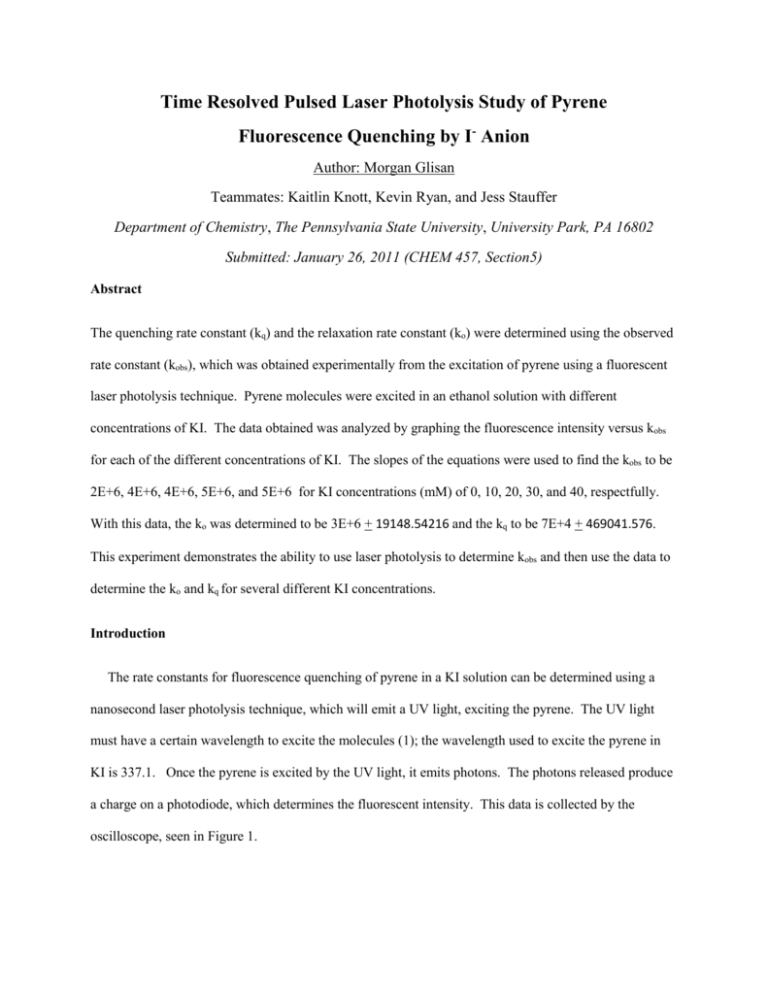
Time Resolved Pulsed Laser Photolysis Study of Pyrene Fluorescence Quenching by I- Anion Author: Morgan Glisan Teammates: Kaitlin Knott, Kevin Ryan, and Jess Stauffer Department of Chemistry, The Pennsylvania State University, University Park, PA 16802 Submitted: January 26, 2011 (CHEM 457, Section5) Abstract The quenching rate constant (kq) and the relaxation rate constant (ko) were determined using the observed rate constant (kobs), which was obtained experimentally from the excitation of pyrene using a fluorescent laser photolysis technique. Pyrene molecules were excited in an ethanol solution with different concentrations of KI. The data obtained was analyzed by graphing the fluorescence intensity versus kobs for each of the different concentrations of KI. The slopes of the equations were used to find the kobs to be 2E+6, 4E+6, 4E+6, 5E+6, and 5E+6 for KI concentrations (mM) of 0, 10, 20, 30, and 40, respectfully. With this data, the ko was determined to be 3E+6 + 19148.54216 and the kq to be 7E+4 + 469041.576. This experiment demonstrates the ability to use laser photolysis to determine kobs and then use the data to determine the ko and kq for several different KI concentrations. Introduction The rate constants for fluorescence quenching of pyrene in a KI solution can be determined using a nanosecond laser photolysis technique, which will emit a UV light, exciting the pyrene. The UV light must have a certain wavelength to excite the molecules (1); the wavelength used to excite the pyrene in KI is 337.1. Once the pyrene is excited by the UV light, it emits photons. The photons released produce a charge on a photodiode, which determines the fluorescent intensity. This data is collected by the oscilloscope, seen in Figure 1. Once the pyrene is excited, the molecules return back to their natural ground state. The lifetime of this excited state is used to determine the rate constants. An increase in the concentration of the solution providing the I- results in a greater rate constant, discussed further in the “Results/Discussions” sections. This relationship is observed in the following equation: 𝐼 = 𝐼𝑜 𝑒 −𝑘𝑡 (1) It can be observed that as the concentration of KI increases, the excited pyrene more quickly returns to the ground state. This is called quenching. Quenching involves introducing a compound that can deactivate the excited. The I- from the KI quenches the excited pyrene molecules. The general equation for rate constants is: − 𝑑[𝐵] 𝑑𝑡 = 𝑘[𝐴][𝐵] (2) KI concentration is much greater than the concentration of the pyrene in the solutions. This makes the pyrene the rate-limiting concentration. Because pyrene is the rate-limiting reaction and the difference in concentrations is so large, a pseudo-first order reaction equation can be used. − 𝑑[𝐵] 𝑑𝑡 = 𝑘 ′ [𝐵] (3) [B] is the rate-limiting reactant. In this case, [B] represents the concentration of pyrene. The goal of this study is to use the fluorescent decay of excited pyrene molecules and the concentration of I- to determine rate constants. The kobs can be determined from the data collected by graphing the fluorescent intensity and time. The kobs in this study will allow the quenching rate constant, kq, and the relaxation rate constant, ko to be determined. This can be done by graphing the kobs and the concentration of I-. Experimental Method The detailed experiment is detailed elsewhere (2), but in brief, 5 samples with concentrations of 0, 10, 20, 30, and 40 mM KI were made with 1 mL of 100 µM pyrene in ethanol and a 50:50 solution of ethanol and water. The solutions were transferred into cuvettes and were purged using a nitrogen line to rid them of oxygen for five minutes because oxygen can additionally quench the pyrene. After purging, a cuvette was placed in the apparatus shown below (Figure 1), which emits the UV light. The voltage of the fluorescent decay was measured by the oscilloscope. FIGURE 1: Set-up for Experimental Process Results/Discussion Using the Mettler AE 100 scale (PSU Serial #: 00122409), 0.1661 + 0.0004 g of KI was weighed. The scale used is very sensitive and can change by the slightest movement in the area. This could have contributed to the experimental error. This was then used to make a 100 + 0.24 mM KI solution, which was distributed to the five 10 + 0.02 mL flasks to make the 0, 10, 20, 30, and 40 mM KI solutions. The observed rate constant, kobs, for each different concentration of KI is listed in Figure 2. Sample Number 0 1 2 3 4 Observed Rate of Reactions and R2 Values [KI] (mM) Kobs (1/s) 0 2.0 *106 10 4.0 *106 20 4.0 *106 30 5.0 *106 40 5.0 *106 R2 0.9985 0.9911 0.9691 0.952 0.9014 FIGURE 2: Table of observed rate constants and R2 for each sample kobs was determined by graphing the fluorescent intensity (volts) versus the time (s). The exponential best fit line and R2 was included on each graph. Using Equation 1, kobs could be determined. Figures 3 and 4 are examples of the graphs used. The other graphs are shown in the Appendix (Figures 6, 7, and 8). Sample 0: Voltage vs Time 0.7 Voltage (volts) 0.6 y = 0.5934e-2E+06x R² = 0.9985 0.5 0.4 0.3 0.2 0.1 0 0 0.0000002 0.0000004 0.0000006 0.0000008 Time (s) FIGURE 3: Example of graph used to determine kobs, Voltage versus Time for Sample 0 (0 mM KI) Sample 3: Voltage vs Time 0.6 Voltage (volts) 0.5 0.4 y = 0.3615e-5E+06x R² = 0.952 0.3 0.2 0.1 0 0 0.0000001 0.0000002 0.0000003 0.0000004 0.0000005 0.0000006 0.0000007 0.0000008 Time (s) FIGURE 4: Example of graph used to determine kobs, Voltage versus Time for Sample 3 (30 mM KI) Once the observed rate constants were determined for each sample, kq and ko were determined. This was done by graphing kobs versus the I- concentration in each sample. The value for kq was represented by the slope of the graph and came to 7E+7 + 469041.576 (mM s)-1. The value for ko was represented by the y-intercept and came to 3E+6 + 19148.54216 s-1. These results can be observed in Figure 5 below. Determining kq 6000000 kobs (1/s) 5000000 4000000 3000000 y = 7E+07x + 3E+06 R² = 0.8167 2000000 1000000 0 0 0.005 0.01 0.015 0.02 0.025 0.03 0.035 0.04 [I-] (mM) FIGURE 5: A graph of kobs versus the concentration of I- to determine ko and kq 0.045 The regression was determined using Microsoft Excel's Data Analysis function. The table for the linear regression is in the Appendix (Figure 9). When using the cuvette for each sample, two different cuvettes were used instead of one. This could have contributed to experimental error because of the difference in the glass of each cuvette. There was no visible difference but the data could have been more standard if the same cuvette was used for each analysis. This could be considered a fairly successful experiment. Based on the equations from the Introduction section, it was determined that an increased I- concentration would result in a larger kobs value. This was proven correct, as seen in Figure 2. As the KI concentration increased, the I- concentration increased, increasing the rate of reaction observed. The R2 values are quite high (>.9) for the fluorescent intensity versus time graphs, showing little regression. This means that the exponential equations are extremely close to the experimental data. The kq and ko values may be less reliable because the R2 value is significantly less than the others (.8167). As seen in Figure 5, the quenching rate of reaction has more effect on the observed rate of reaction than ko, which is due to the quenching effects of I- on pyrene. Conclusion In summary, the expected outcome was observed in this study. The observed rate of reaction increased as the KI concentration increased. The kobs, determined through graphing the fluorescent intensity versus time, came to be 2E+6, 4E+6, 4E+6, 5E+6, and 5E+6 s-1 for KI concentrations of 0, 10, 20, 30, and 40 mM. This was expected because as the I- concentration increased with the KI concentration, the quenching rate constant increased. Using the kobs values, ko and kq were determined graphically. The results seem to hold true to the theories behind the study, including that the effect of the concentration of the quenching molecule, I- in this study, is important to the observed rate of reaction. References (1) Fluorescent Spectroscopy. CHE 425L Lab Handout. Oswego University. <oswego.edu>. [Online]. (2) Milosavljevic, B.H. Lab Packet for CHEM 457: Experimental Physical Chemistry, Time Resolved Pulsed Laser Photolysis Study of Pyrene Fluorescence Quenching by I- Anion. University Press: University Park, 2011. (3) The Rate Constant for Fluorescence Quenching. Lab Handout. Colby College. <colby.edu>. [Online]. Appendix Sample 1: Voltage vs Time 0.7 Voltage (volts) 0.6 0.5 0.4 y = 0.5389e-4E+06x R² = 0.9911 0.3 0.2 0.1 0 0 0.0000002 0.0000004 0.0000006 0.0000008 Time (s) FIGURE 6: Example of graph used to determine kobs, Voltage versus Time for Sample 0 (10 mM KI) Sample 2: Voltage vs Time 0.7 Voltage (volts) 0.6 0.5 y = 0.4444e-4E+06x R² = 0.9691 0.4 0.3 0.2 0.1 0 0 0.0000002 0.0000004 0.0000006 0.0000008 Time (s) FIGURE 7: Example of graph used to determine kobs, Voltage versus Time for Sample 0 (20 mM KI) Voltage (volts) Sample 4: Voltage vs Time 0.7 0.6 0.5 0.4 0.3 0.2 0.1 0 y = 0.284e-5E+06x R² = 0.9014 0 0.0000002 0.0000004 0.0000006 0.0000008 Time (s) FIGURE 8: Example of graph used to determine kobs, Voltage versus Time for Sample 0 (4 mM KI) FIGURE 9: Linear regression from Microsoft Excel to determine ko and kq Calculation for KI Mass: .10 mL of .1 M KI solution Molar mass of KI: 166.0 g/mol 0.1 𝑚𝑜𝑙 𝐾𝐼 1𝐿 166.0 𝑔 [ ][ ] [10 𝑚𝐿] = .166 𝑔 𝐾𝐼 𝐿 1000 𝑚𝐿 𝑚𝑜𝑙 𝐾𝐼 Error Analysis for 100 mM KI Soultion 𝑚𝑜𝑙𝑒𝑠 𝑜𝑓 𝐾𝐼 = [. 1661 ± .0004 𝑔 𝐾𝐼] [ 𝑚𝑜𝑙 ] = .001 ± 2.41 × 10−6 𝑚𝑜𝑙 𝐾𝐼 166.0 𝑔 𝐾𝐼 . 001 ± 2.41 × 10−6 𝑚𝑜𝑙 𝐾𝐼 = 100 ± .24 𝑚𝑀 𝐾𝐼 10 ± .012 𝑚𝐿
